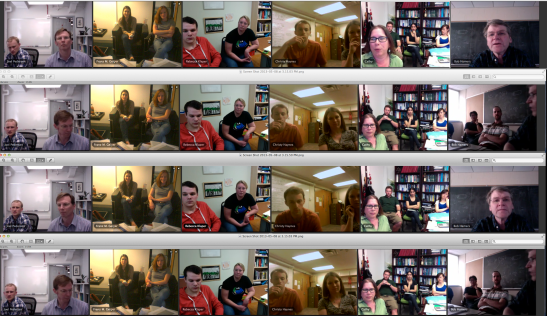This blog post comes at a time when our center is probing the nano-bio interface (see prior blog entries below) with one of the largest collection of scientific research instrumentation to which I have ever had access. The Center for Sustainable Nanotechnology has researchers at 5 universities across the Midwest as well as the Pacific Northwest National Laboratory in Washington. By working in a multi-institutional team, each center member has direct access to each university’s analytical facilities, as well as the many state-of-the-art instruments housed at Pacific Northwestern National Laboratory. Plus, there’s bound to be at least one, if not more, expert in one of our institutions who knows how to do a particular experiment well.

Want to measure exactly how small our nanoparticles are? Use a zeta sizer, transmission electron microscope (blog entry), or atomic force microscope. Need to know what’s surrounding a nanomaterial once it’s been in contact with a cell membrane? Use nuclear magnetic resonance (blog entry), transmission electron microscopy, X-ray photoelectron spectroscopy, or atomic force microscopy. Wish to know if certain nanomaterials attract certain molecules within a biomembrane? Use structured illumination microscopy. Need to know how many nanograms of a given nanomaterial are attached to particular interface? Use a quartz crystal microbalance (blog entry). Want to know the charges of a nanomaterial attached to an interface? Use nonlinear laser spectroscopy (blog entry 1, blog entry 2).

Taking advantage of the research-multiplying effect that arises from working in a geographically distributed, as opposed to localized, center is, at first glance, an easy thing to do: call your colleagues, ship over a sample, analyze the data in the context of what everybody else finds. Yet, it is surprisingly difficult to synchronize the various steps that are involved in this activity.
First, one needs a certain amount of a well-characterized nanomaterial sample. Often, the sample needs to be freshly prepared, as many of our nanomaterials sediment out of solution through a process called coagulation. With a fresh sample in hand, one needs to find the right persons to do the right measurements on the right instruments. Yet, those folks are often busy working on other samples that are equally time-sensitive. So, one needs a prioritization step every now and then to decide, as a team, which experiments take precedent over others. Often, the experiments that are of highest priority are those that are almost complete, or closest to publication. Experiments performed on entirely new classes of compounds take high priority as well, as they open up prospects for long-term research avenues. Experiments that are in the middle of their cycle of investigation may sometimes take lower priority. To satisfy all the scientists needs, priorities are reviewed and adjusted on a regular basis via weekly all-hands meetings and, often daily, individual teleconferences.

With data from many instruments in hand, the team then has a multi-dimensional view of how a certain nanomaterial formulation interacts with biological and environmental surfaces. A key advantage in having access to many different pieces of information that were obtained from instruments located in different laboratories is that we can easily identify which pieces of data support the same conclusion. However, we are always on the look-out for results that contradict one another. The key when approaching this issue is to eliminate irreproducible results and experimental artifacts by performing experiments in triplicate to assess reproducibility and by carrying out counterfactuals, or controls. The responses that persist then provide an opportunity to see science that has never been seen before, while at the same time having data from independent experiments that put the new discoveries into context. Such a result is particularly exciting when it is unexpected, as it would have most likely been dismissed in a scientific activity that has access to only a limited set of instrumentation.
Taken together then, we find that there is almost no reason anymore for scientists who are part of a geographically distributed center, and who have (almost) all the tools they need to do science, to not do the best research. At the Center for Sustainable Nanotechnology, we aim to do just that, while also providing best practices for working collaboratively in a geographically distributed center.
Previous Entries Related to the Nano-Bio Interface:
How I Study Nanoparticles’ Interactions with Biological Soup
Spying on chameleon nanoparticles inside living cells
Scientists work to prevent a nano-crisis
One of the Most Sensitive Balances on the Planet – Quartz Crystal Microbalance
Zooming in on the Nano World: Limitations and Breakthroughs in Light Microscopy
Surfing Particles: taking a ride using living cell machinery
The Canary in the Coal Mine and a Whole Lot More: The Reproductive Habits and Scientific Utility of the Water Flea
“Size Matters Not” or “How tiny water fleas make a BIG difference in the science world”

[…] may come as a shock to some of you, but scientists do have friends beyond their favorite pipette or scientific instrument of choice. I meet up for a lovely dinner with a former colleague from my soil science days, her husband, and […]